Related Research Articles

General surgery is a surgical specialty that focuses on alimentary canal and abdominal contents including the esophagus, stomach, small intestine, large intestine, liver, pancreas, gallbladder, appendix and bile ducts, and often the thyroid gland. They also deal with diseases involving the skin, breast, soft tissue, trauma, peripheral artery disease and hernias and perform endoscopic as such as gastroscopy, colonoscopy and laparoscopic procedures.

Ulcerative colitis (UC) is a long-term condition that results in inflammation and ulcers of the colon and rectum. The primary symptoms of active disease are abdominal pain and diarrhea mixed with blood (hematochezia). Weight loss, fever, and anemia may also occur. Often, symptoms come on slowly and can range from mild to severe. Symptoms typically occur intermittently with periods of no symptoms between flares. Complications may include abnormal dilation of the colon (megacolon), inflammation of the eye, joints, or liver, and colon cancer.

Laparoscopy is an operation performed in the abdomen or pelvis using small incisions with the aid of a camera. The laparoscope aids diagnosis or therapeutic interventions with a few small cuts in the abdomen.

Appendicitis is inflammation of the appendix. Symptoms commonly include right lower abdominal pain, nausea, vomiting, and decreased appetite. However, approximately 40% of people do not have these typical symptoms. Severe complications of a ruptured appendix include widespread, painful inflammation of the inner lining of the abdominal wall and sepsis.

An appendectomy, also known as an appendicectomy, is a surgical operation in which the vermiform appendix is removed. Appendectomy is normally performed as an urgent or emergency procedure to treat complicated acute appendicitis.

In vertebrates, the gallbladder, also known as the cholecyst, is a small hollow organ where bile is stored and concentrated before it is released into the small intestine. In humans, the pear-shaped gallbladder lies beneath the liver, although the structure and position of the gallbladder can vary significantly among animal species. It receives and stores bile, produced by the liver, via the common hepatic duct, and releases it via the common bile duct into the duodenum, where the bile helps in the digestion of fats.
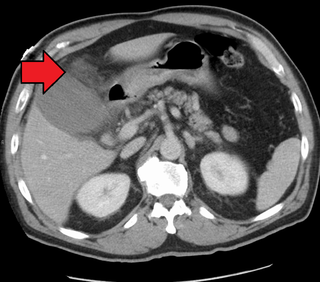
Cholecystitis is inflammation of the gallbladder. Symptoms include right upper abdominal pain, pain in the right shoulder, nausea, vomiting, and occasionally fever. Often gallbladder attacks precede acute cholecystitis. The pain lasts longer in cholecystitis than in a typical gallbladder attack. Without appropriate treatment, recurrent episodes of cholecystitis are common. Complications of acute cholecystitis include gallstone pancreatitis, common bile duct stones, or inflammation of the common bile duct.

Cholecystectomy is the surgical removal of the gallbladder. Cholecystectomy is a common treatment of symptomatic gallstones and other gallbladder conditions. In 2011, cholecystectomy was the eighth most common operating room procedure performed in hospitals in the United States. Cholecystectomy can be performed either laparoscopically, or via an open surgical technique.

Abdominal pain, also known as a stomach ache, is a symptom associated with both cancer and serious medical issues.
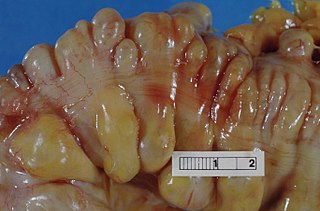
Diverticulitis, also called colonic diverticulitis, is a gastrointestinal disease characterized by inflammation of abnormal pouches—diverticula—which can develop in the wall of the large intestine. Symptoms typically include lower abdominal pain of sudden onset, but the onset may also occur over a few days. There may also be nausea; and diarrhea or constipation. Fever or blood in the stool suggests a complication. Repeated attacks may occur.
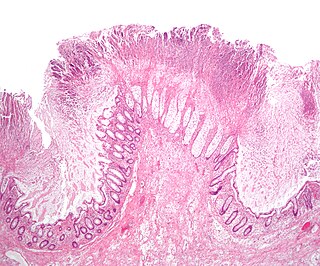
Toxic megacolon is an acute form of colonic distension. It is characterized by a very dilated colon (megacolon), accompanied by abdominal distension (bloating), and sometimes fever, abdominal pain, or shock.

Common bile duct stone, also known as choledocholithiasis, is the presence of gallstones in the common bile duct (CBD). This condition can cause jaundice and liver cell damage. Treatments include choledocholithotomy and endoscopic retrograde cholangiopancreatography (ERCP).
In medicine, the ileal pouch–anal anastomosis (IPAA), also known as restorative proctocolectomy (RPC), ileal-anal reservoir (IAR), an ileo-anal pouch, ileal-anal pullthrough, or sometimes referred to as a J-pouch, S-pouch, W-pouch, or a pelvic pouch, is an anastomosis of a reservoir pouch made from ileum to the anus, bypassing the former site of the colon in cases where the colon and rectum have been removed. The pouch retains and restores functionality of the anus, with stools passed under voluntary control of the person, preventing fecal incontinence and serving as an alternative to a total proctocolectomy with ileostomy.

Colectomy is bowel resection of the large bowel (colon). It consists of the surgical removal of any extent of the colon, usually segmental resection. In extreme cases where the entire large intestine is removed, it is called total colectomy, and proctocolectomy denotes that the rectum is included.
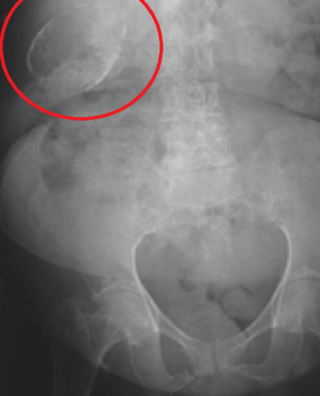
Porcelain gallbladder is a calcification of the gallbladder believed to be brought on by excessive gallstones, although the exact cause is not clear. As with gallstone disease in general, this condition occurs predominantly in overweight female patients of middle age. It is a morphological variant of chronic cholecystitis. Inflammatory scarring of the wall, combined with dystrophic calcification within the wall transforms the gallbladder into a porcelain-like vessel. Removal of the gallbladder (cholecystectomy) is the recommended treatment.
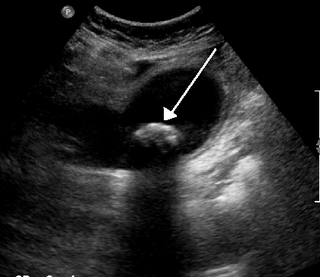
Biliary colic, also known as symptomatic cholelithiasis, a gallbladder attack or gallstone attack, is when a colic occurs due to a gallstone temporarily blocking the cystic duct. Typically, the pain is in the right upper part of the abdomen, and can be severe. Pain usually lasts from 15 minutes to a few hours. Often, it occurs after eating a heavy meal, or during the night. Repeated attacks are common.
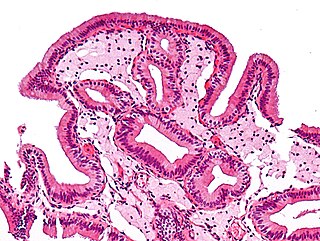
Gallbladder diseases are diseases involving the gallbladder and is closely linked to biliary disease, with the most common cause being gallstones (cholelithiasis).
Ned Abraham was an associate professor of surgery at the Faculty of Medicine, University of New South Wales and is a general & colorectal surgeon, a clinical academic and a retired Australian Army Reserve Officer. He has spoken at multiple national and international meetings in four continents and his published articles in general, colorectal and academic surgery have been cited in the medical literature close to two thousand times. He continues to practice surgery in Coffs Harbour, NSW, Australia.
Erich Mühe was a German surgeon known for performing the first laparoscopic cholecystectomy in 1985.

Conor P. Delaney MD, MCh, PhD, FRCSI, FACS, FASCRS, FRCSI (Hon.) is an Irish-American colorectal surgeon, CEO and President of the Cleveland Clinic Florida, the Robert and Suzanne Tomsich Distinguished Chair in Healthcare Innovation, and Professor of Surgery at the Cleveland Clinic Lerner College of Medicine. He is also the current President of the American Society of Colon and Rectal Surgeons (ASCRS). He was previously Chairman of the Digestive Disease & Surgery Institute at the Cleveland Clinic. He is both a Fellow and Honorary Fellow of the Royal College of Surgeons in Ireland and a Fellow of both the American College of Surgeons and American Society of Colon and Rectal Surgeons.
References
- ↑ "Surgical extripation". Encyclopædia Britannica. Retrieved 26 April 2020.
- ↑ "therapeutics - Surgical therapy - medicine". Encyclopedia Britannica. Retrieved 2017-09-01.
- ↑ Longo, Dan L.; et al., eds. (2012). Harrison's principles of internal medicine (18th ed.). New York: McGraw-Hill. p. Chapter 300. ISBN 978-0-07174889-6 . Retrieved 1 September 2017.
- ↑ Tintinalli, Judith E. (2011). Emergency medicine : a comprehensive study guide (7. ed.). New York: McGraw-Hill. p. Chapter 84. ISBN 978-0-07-174467-6 . Retrieved 1 September 2017.
- ↑ Mason, RJ (August 2008). "Surgery for appendicitis: is it necessary?". Surgical Infections. 9 (4): 481–8. doi:10.1089/sur.2007.079. PMID 18687030.
- ↑ Kornbluth A, Sachar DB (2004). "Ulcerative colitis practice guidelines in adults (update): American College of Gastroenterology, Practice Parameters Committee". The American Journal of Gastroenterology. 99 (7): 1371–85. doi:10.1111/j.1572-0241.2004.40036.x. PMID 15233681. S2CID 18310799.
- ↑ Ulcerative colitis at eMedicine
- ↑ Neri V; Ambrosi A; Fersini A; Tartaglia N; Valentino TP (2007). "Antegrade dissection in laparoscopic cholecystectomy". Journal of the Society of Laparoendoscopic Surgeons. 11 (2): 225–8. PMC 3015719 . PMID 17761085.
- ↑ "Gallstones". NIDDK. November 2013. Retrieved 1 September 2017.
- ↑ Bardakcioglu, Ovunc; Khan, Ashraf; Aldridge, Christopher; Chen, Jiajing (August 2013). "Growth of laparoscopic colectomy in the United States: analysis of regional and socioeconomic factors over time". Annals of Surgery. 258 (2): 270–274. doi:10.1097/SLA.0b013e31828faa66. ISSN 1528-1140. PMID 23598378. S2CID 24929078.
- ↑ Reynolds, Walker (2001). "The First Laparoscopic Cholecystectomy". Journal of the Society of Laparoendoscopic Surgeons. 5 (1): 89–94. ISSN 1086-8089. PMC 3015420 . PMID 11304004.